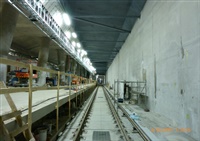
- Bundle:
- Fall Conference Bundle
- Presenters:
- Nate Rende
- Duration:
- 37 Minutes
- Format:
- Audio and Video
- License:
- Access for 6 month(s) after purchase.
- Short Description:
- Nondestructive testing is often used in conjunction with traditional methods to assess construction, material, or structural deficiencies in new construction. This presentation describes evaluation of unique delamination failures within below-grade, exterior walls of a new subway station. The walls were conventionally reinforced mass concrete cast against a soldier pile and lagging retention system. Shortly after construction, leakage at cracks and joints was observed and injection processes led to delamination of the interior surfaces. The assessment objectives were to determine the extent and cause of near-surface discontinuities and evaluate the structural integrity of the walls. Nondestructive testing included flaw detection using Impulse Response [structural mobility testing] and reinforcement locating using ground-penetrating radar. Sampling and petrographic examinations were conducted to correlate test results with distress conditions and evaluate the in-situ concrete.
- Price:
- $15.00 - $25.00
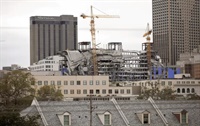
- Bundle:
- Fall Conference Bundle
- Presenters:
- Peter Barlow
- Duration:
- 36 Minutes
- Format:
- Audio and Video
- License:
- Access for 6 month(s) after purchase.
- Short Description:
- A significant percentage of repairs are performed during the course of constructing new structures. Once a construction anomaly or error occurs the first concerns are for life safety and schedule impact. A review of the steps necessary to successfully perform repairs and minimize impacts to the ongoing construction. Examples of challenging problems and the traditional and non-traditional solutions to these problems will be discussed.
- Price:
- $15.00 - $25.00

- Presenters:
- Farhad Habibi, PhD | Justin Breg, PhD
- Duration:
- 36 Minutes
- Format:
- Audio and Video
- License:
- Access for 6 month(s) after purchase.
- Short Description:
- Alkali-Silica Reaction (ASR) can cause significant damage to concrete structures including bridges, roadways, airport runways, and nuclear power plants. When reactive aggregates are included in a mix, the presence of moisture initiates a reaction between the alkaline cement paste and reactive amorphous silica. The result is a gel that continues to dilate, which may cause cracks in the concrete mass. A research program was undertaken at the University of Toronto to investigate the effects of ASR on large-scale and small-scale concrete specimens. Several specimens were constructed using reactive (ASR) concrete and non-reactive (regular) concrete, and their short-term and long-term structural and mechanical behavior were compared. In this presentation, we will discuss the results of the research program, will offer best practices to minimize the risk of ASR in concrete during placement, and will propose several strategies for repair of structures that have been degraded due to ASR.
- Price:
- $15.00 - $25.00
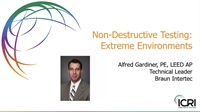
- Presenters:
- Alfred Gardiner
- Duration:
- 34 Minutes
- Format:
- Audio and Video
- License:
- Access for 6 month(s) after purchase.
- Short Description:
- Two projects will be explored in this presentation. The first is a concrete structure which for 20 years was exposed to extreme heat. The second is a structure which was exposed to extreme vibrations. Both these structures were integral parts of manufacturing processes and required limited down time to repair. The questions needing to be answered were: what is the condition of the existing concrete and what are the repair options for these structures. We turned to non-destructive techniques to evaluate these structures. Non-destructive techniques can provide insight into structures when accompanied by experienced engineers and petrographic analysis. Repair options were provided at the end of our evaluation leading to reduced down time and well-planned repairs.
- Price:
- $15.00 - $25.00
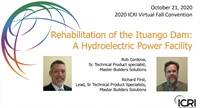
- Presenters:
- Robert M Cordova | Richard First
- Duration:
- 30 Minutes
- Format:
- Audio and Video
- License:
- Access for 6 month(s) after purchase.
- Short Description:
- The Ituango dam is an embankment dam that is currently under construction on the Cauca River in Colombia. The largest hydroelectric power plant in Colombia’s history. Three large diversion tunnels used to divert the water from the river around the construction site during construction collapsed as a result of heavy rainfalls. The nearly completed pump house had to be flooded to accommodate premature water build-up in the reservoir. These tunnels would need to be permanently sealed. “Pre-stoppers” would need to be constructed in place to serve as bulk heads between which would ultimately be excavated and back-filled with concrete to permanently seal the tunnels. Additional to standard anti-washout properties, the grout had to withstand swiftly flowing water and exhibit an extended working time at temperatures above 32 degrees C. A custom grout was developed for this application. In the end, hundreds of grout micropiles were tremied, consuming more than 1,650 tons of grout, to produce...
- Price:
- $15.00 - $25.00
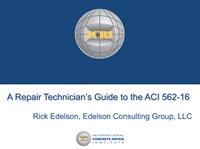
- Presenters:
- Rick Edelson, P.E.
- Duration:
- 30 Minutes
- Format:
- Audio and Video
- License:
- Access for 6 month(s) after purchase.
- Short Description:
- The ACI 562-16 Repair Code is primarily intended for the Licensed Design Professional for providing the requirements necessary for assessing and designing repairs and rehabilitation of existing concrete structures.
- Price:
- $0.00 - Base Price
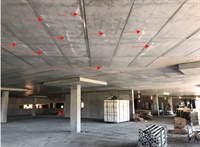
- Presenters:
- Nigel Parker
- Duration:
- 29 Minutes
- Format:
- Audio and Video
- License:
- Access for 6 month(s) after purchase.
- Short Description:
- The Avalon Mall parking facility is a four level above grade structure, consisting of three suspended parking levels (approximately 7,750sq.m. each) and one on-grade parking level connected to the existing mall with a new pedestrian bridge. RJC was the structural engineer of record. During construction of the parking structure extensive cracking of the suspended parking garage slabs was noted at two of the 24 pours. RJC undertook a visual assessment of the parking slabs in question to determine the extent of the noted cracking and determined over 750lin.m. of cracks ranging in size from 0.5mm to 6.5mm in width. Following the visual assessment destructive testing of the concrete was undertaken to determine its in-situ properties as well as to understand the full extent of the cracking.
- Price:
- $15.00 - $25.00
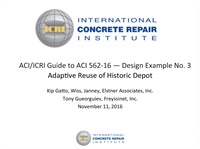
- Presenters:
- Kip Gatto, P.E.
- Duration:
- 29 Minutes
- Format:
- Audio and Video
- License:
- Access for 6 month(s) after purchase.
- Short Description:
- This video will illustrate an example of how various sections of ACI 562 are applied in the execution of a complex repair project, the repurposing of a historic train deck into a transportation hub for light rail trains and busses. Methods of evaluation and analysis, as guided by ACI 562, will be presented with a discussion of how these provisions lead to various repair approaches presented to the owner.
- Price:
- $0.00 - Base Price
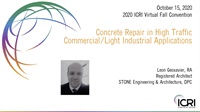
- Presenters:
- Leon Geoxavier
- Duration:
- 29 Minutes
- Format:
- Audio and Video
- License:
- Access for 6 month(s) after purchase.
- Short Description:
- High Traffic Commercial/Light Industrial applications including light manufacturing, warehouse/big-box stores and high traffic retail applications present their own unique challenges in concrete repair. This presentation will review concrete repair options that a focused on those application that may require both fast application/turnaround time and strength/use durability for forklifts and trucks. High Traffic Commercial/Light Industrial applications including light manufacturing, warehouse/big-box stores and high traffic retail applications present their own unique challenges in concrete repair. This presentation will review concrete repair options that a focused on those application that may require both fast application/turnaround time and strength/use durability for forklifts and trucks. While there are many option for quick repair that can be open to use in a matter of hours, it is important to acknowledge he potential limitations of these options over the long term.
- Price:
- $15.00 - $25.00
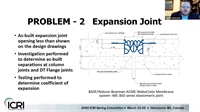
- Bundle:
- Fall Conference Bundle
- Presenters:
- Anirudh Goel | Mr Charles Hammond
- Duration:
- 28 Minutes
- Format:
- Audio and Video
- License:
- Access for 6 month(s) after purchase.
- Short Description:
- The presentation, through case studies, talks about emergency response services for structural issues encountered during construction of new design projects. Among other examples is an eleven story precast parking structure. The contractor observed significant diagonal faulted cracking of L-beams (supporting double-tee sections) near bearing locations, few days after pouring topping slab. In addition, inverted-tee girders were observed to be supported on cracked corbels at other locations. A quick turn around was required to mitigate any immediate life safety hazard posed by the structural distresses and buy time for thorough investigation, non-destructive testing, analyses, and repair design. Another example is a seven story precast parking structure. The structure was under construction and reportedly erected out of plumb. Poor concrete placing practices and poor weld detailing led to widespread cracking in multiple structural elements throughout the structure...
- Price:
- $15.00 - $25.00
Please wait ...